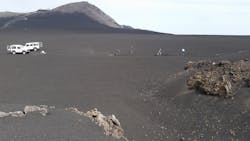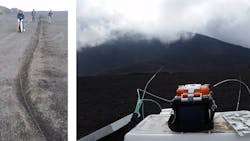Fiber-optic sensor effectively monitors volcanic activity
Historically, volcanic eruptions and related events have been largely unpredictable. Scientists can monitor this activity with such tools as seismometers, thermal imaging, and GPS mapping—but only to a point. Now, a highly sensitive technique has emerged, with fiber optics at its core.
Most commonly, volcanic activity is monitored by measuring earthquakes and tremor vibrations. Yet, it’s difficult to detect subtle triggering mechanisms of volcanic activity (including gas emissions and magnetic fields) in this way. Among challenges is the distortion of measurement signals by underground structures.
Led by Dr. Philippe Jousset, a scientist and researcher with the GFZ German Research Centre for Geosciences (Potsdam, Germany), and Gilda Currenti, a researcher at Italy’s National Institute of Geophysics and Volcanology, the team developed a method using fiber-optic cables as sensors analyzing the light backscattered in the cables when deformed by vibrations. The technique—distributed acoustic sensing (DAS) with optical fibers—allows for more accurate identification of volcanic events remotely and image hidden near-surface volcanic structural features.
Putting their research into practice, the team is monitoring one of the world’s most active volcanos, Mount Etna in Sicily, Italy (see Fig. 1). They have been able to detect and characterize strain signals associated with explosions in Mount Etna and locate their origin with a 2D template matching picked and theoretical wave arrival times. Wavefield separation has enabled researchers to “incrementally investigate the ground response to various excitation mechanisms,” and “identify very small volcanic events” related to fluid migration and degassing.
"The cable, deployed in a scoria layer, was capable of sensing strain changes associated to Etnean volcanic activity such as volcanic explosions, small volcanic degassing, local volcano-tectonic earthquakes, as well as to atmospheric phenomena including hail and thunderstorms,” Jousset says.
In determining sustainability for measuring weak seismic and volcanic activity, the researchers sent a 1.3-km-long fiber-optic cable about 20 cm deep in a scoria layer—the dark igneous rock in a volcano that features round, bubble-like cavities (vesicles)—at a distance of about 2 km from Etna’s summit craters (see Fig. 2). They were able to measure changes in the cable caused by volcanic activity.When sending a train of light pulses into an optical fiber with a laser, researchers note the light was partially backscattered by the fiber’s natural imperfections. The travel time of the light changed when the fiber stretched or deformed, thanks to minute ground movements, acoustic waves, and temperature changes. The consecutive placement of the light pulses provided precise measurements along the entire length of the optical fiber.
“The spatial resolution offered by fiber-optic strain measurements allows it to extract and amplify very small but important signals that were previously out of reach for quantitative analysis,” says researcher Dr. Benjamin Schwarz, a scientist with GFZ.
This work has allowed researchers “to detect and characterize both volcanic explosions as well as the nonlinear interactions of the then-propagating acoustic wave with the near-surface scoria deposits, triggering resonance phenomena in the subsurface,” according to the study.
The new fiber-optic sensor’s long-distance probing capabilities (currently at least several tens of kilometers, according to the researchers) allows an interrogator to be set up in a remote location, making observations easier and safer than conventional sensor arrays.
“This is a new contribution that advances the understanding of volcanic processes,” Currenti says. “This technique will become a standard for volcano monitoring in the years to come.”
About the Author
Justine Murphy
Multimedia Director, Digital Infrastructure
Justine Murphy is the multimedia director for Endeavor Business Media's Digital Infrastructure Group. She is a multiple award-winning writer and editor with more 20 years of experience in newspaper publishing as well as public relations, marketing, and communications. For nearly 10 years, she has covered all facets of the optics and photonics industry as an editor, writer, web news anchor, and podcast host for an internationally reaching magazine publishing company. Her work has earned accolades from the New England Press Association as well as the SIIA/Jesse H. Neal Awards. She received a B.A. from the Massachusetts College of Liberal Arts.


